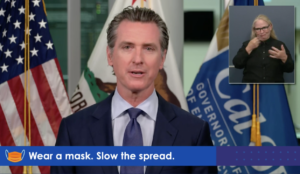Citing evidence that younger learners pose a lower risk of transmitting COVID-19, Governor Gavin Newsom on Wednesday announced a new plan encouraging a return to in-person classroom instruction for elementary school students as early as mid-February.
During a morning briefing, Newsom released details of California’s Safe Schools for All plan, which prioritizes a phased-in approach for returning students in kindergarten through the second grade, as well as those with special needs. Upper elementary grades could be incentivized to resume on-site classes as early as March. Information for secondary schools has not yet been released.

“By focusing on a phased approach with virus mitigation and prevention at the center, we can begin to return our kids to school to support learning needs and restore the benefits of in-person instruction,” Newsom said. “It’s especially important for our youngest kids, those with disabilities, those with limited access to technology at home and those who have struggled more than most with distance learning.”
At the center of the plan is a $2 billion investment to help campuses reopen safely and to support those that are already open — which is the case for a number of Orange County districts. The state funding would pay for more COVID-19 testing for educators and students, ventilation upgrades and personal protective equipment in schools.
More information is forthcoming, but here’s a brief breakdown of what the plan includes so far, which still requires legislative approval:
- Increased testing: The state will work toward testing all school staff and students, with the frequency of testing depending on the county’s reopening tier.
- PPE: Educators will be asked to wear surgical masks and all students will be required to wear masks in the classroom. Schools will receive more surgical masks from the state at no cost.
- Contact tracing: State contact tracers will monitor schools and help coordinate with local health agencies.
- Vaccinations: School staff will be prioritized as part of Phase 1B of vaccination distribution. Educators and child care workers can expect to receive vaccines as soon as early January.
- Oversight and assistance: A cross-agency team with staff from the California Department of Public Health, Cal/OSHA and educational agencies will help schools develop and implement their COVID-19 safety plans. Supports will include site visits as warranted, along with webinars, training materials and ongoing technical assistance.
- Transparency and accountability: A state dashboard will enable all Californians to see their school’s reopening status, level of available funding, and data on in-school transmissions. Additionally, a web-based “hotline” will also be available to provide information on a school’s reopening status and data on coronavirus outbreaks.
School districts will be required to submit their COVID-19 safety plans to local and state officials, which will monitor, provide support and enforce guidelines.
Newsom said schools must be in counties with a seven-day average of less than 28 cases per 100,000 residents to reopen. Orange County’s rate was 53.5 as of Wednesday, but a number of local schools were allowed to reopen with precautions back when the county was in a less restrictive tier.
According to the governor, the new plan would incentivize, but not mandate, a return to on-site instruction. Distance learning will still remain an option for families and students who choose it.
Orange County Superintendent Dr. Al Mijares had this to say about the governor’s plan:
While we are still learning the details of this plan, we are interested in any support that can help provide more in-classroom instruction while keeping our students and employees safe. Amid the challenges and disruptions we’ve faced during the pandemic, we are grateful to the governor and the Legislature for their commitment to making sure schools remain a top priority and for continuing to pursue opportunities to increase student attendance, especially for our most vulnerable populations.
As we’ve seen with Orange County districts that have reopened their campuses to students, resuming in-person instruction requires great collaboration and consensus on multiple fronts. We recognize now may not be the time to reopen all campuses, especially in those areas hardest hit by COVID-19. Yet we remain optimistic that there is light at the end of the tunnel, and we will continue our fight to prevent learning loss and to establish systems of instructional delivery that support students at home and in the classroom.
Additional details and a rationale for the new plan can be found on the CDPH website.
